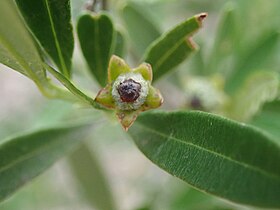| Bertya opponens | |
|---|---|

| |
| Fruit (Deriah Aboriginal Area) | |
| Conservation status | |
 Vulnerable (EPBC Act) | |
| Scientific classification | |
| Kingdom: | Plantae |
| Clade: | Tracheophytes |
| Clade: | Angiosperms |
| Clade: | Eudicots |
| Clade: | Rosids |
| Order: | Malpighiales |
| Family: | Euphorbiaceae |
| Genus: | Bertya |
| Species: | B. opponens |
| Binomial name | |
| Bertya opponens (F.Muell. ex Benth.) Guymer | |

| |
| Occurrence data from the Australasian Virtual Herbarium | |
| Synonyms | |
|
Bertya oppositifolia F.Muell. & O'Shanesy | |
Bertya opponens is a shrub/tree in the family Euphorbiaceae, native to Australia and found in New South Wales and Queensland. It is found on ridges amongst mallee in shallow soils. It flowers in July and August.
Description
Bertya opponens is a shrub or small tree growing to 4 m high, and has a dense covering of whitish to brownintertwined hairs. The leaves are mostly opposite, and are 10–50 mm long and 5–25 mm wide, with glands at the apex. The leaves have hairy upper surfaces, which become rough with age, and lower surfaces which are densely covered with intertwined white hairs, and having a prominent midrib. The leaf margins are recurved to revolute. The leaf stalk (petiole) is 3–5 mm long. The flowers are both stalked and stalkless. The plant carries 1–3 male and female flowers together. There are four narrow conspicuous bracts, 2–5 mm long, which are densely covered in matted yellowish brown hairs, and two inner bracts which may or may not be obscure, and which are very sticky. There are four perianth segments which are broad-ovate, 5–6 mm long, and mostly hairless and sticky. In the female flower, the segments fused towards the base. The ovary is densely covered with unmatted hairs (villous) and is mostly four-lobed. The capsule is almost spherical, about 8–9 mm long, and densely covered with long shaggy hairs which are not matted.
The species was first described as Croton opponens by Ferdinand von Mueller in 1873, and redescribed by Guymer in 1985 as a Bertya, giving the name, Bertya opponens.
Gallery
References
- ^ "Bertya opponens R.Br". PlantNET – FloraOnline. National Herbarium of NSW. Retrieved 2019-06-22.
- Species Profile and Threats Database: Species profile Bertya opponens. Accessed 23 June 2019.
- ^ "Bertya opponens". Australian Plant Name Index, IBIS database. Centre for Plant Biodiversity Research, Australian Government.. Accessed 22 June 2019.
- ^ Guymer, G.P. (1985) A name change in the genus Bertya (Euphorbiaceae). Austrobaileya 2(2): 147 JSTOR
- Govaerts, R. et al. (2019) Plants of the world online: Bertya opponens. Board of Trustees of the Royal Botanic Gardens, Kew/ Accessed 22 June 2019.
- "Bertya opponens – Occurrence records". The Australasian Virtual Herbarium. Council of Heads of Australasian Herbaria. Retrieved 2019-06-22.
- Barrett, R. (2017) Bertya opponens. In: Flora of Australia. Australian Biological Resources Study, Department of the Environment and Energy, Canberra. Accessed: 22 June 2019.
- Bentham, G. (1873) Flora Australiensis 6: 125
- "Croton opponens". Australian Plant Name Index, IBIS database. Centre for Plant Biodiversity Research, Australian Government.. Accessed 22 June 2019.
External links
- Bertya opponens (National recovery plan)
- Bertya opponens - vulnerable species listing, Office of Environment and Heritage, NSW
- Coolabar Bertya profile, Office of Environment and Heritage, NSW
- Bertya opponens (specimen k000959526)
| Taxon identifiers | |
|---|---|
| Bertya opponens |
|
| Croton opponens | |
This Euphorbiaceae-related article is a stub. You can help Misplaced Pages by expanding it. |


